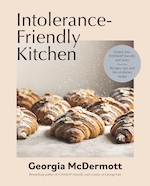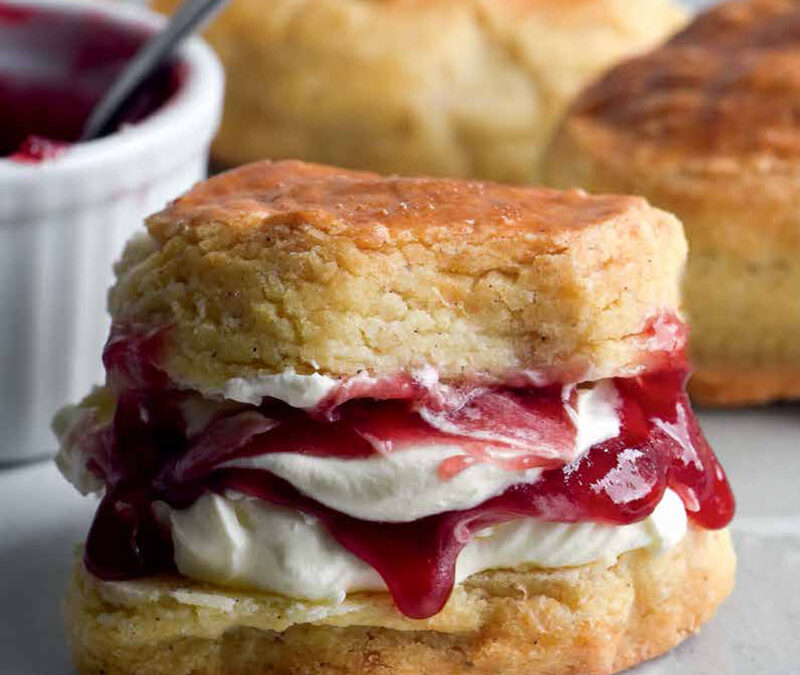Lactose free, egg free, FODMAP friendly and gluten free, these vegan scones are suitable for everyone. There’s even a gum-free option.
There’s a time and a place for recipes that avoid high-starch flours. Gluten-free, vegan scones are not one of those times or those places.
Second only to croissants, scones have been my biggest challenge to date. While I’m happy to say I’ve cracked the case, I recommend sticking to the flours suggested. The glutinous rice flour and potato starch work like a charm to create a light and fluffy scone without spreading.
This recipe also works well with regular butter and milk and a regular egg wash—the butter will only need to chill for 10 minutes or so before proceeding with the recipe.
Prep time: 35 minutes
Chilling time: 25–30 minutes
Cook time: 25 minutes
Makes 5–6 large scones
Ingredients
- 160 g (1 cup) fine white rice flour
- 60 g (½ cup) glutinous rice flour
- 60 g (½ cup) potato starch
- 3 teaspoons gluten-free baking powder
- ½ teaspoon bicarbonate of soda
- ½ teaspoon xanthan gum or 2 teaspoons
- psyllium husk powder
- 40 g caster sugar
- 100 g plant-based butter (I used Nuttelex Buttery), cubed and chilled in freezer for 30 minutes
- 180–250 ml (¾–1 cup) FODMAP-friendly, plant-based milk of choice (see notes)
- 1 tablespoon white vinegar
To finish
- 1 tablespoon FODMAP-friendly plant-based milk mixed with 2 teaspoons pure maple syrup (see notes)
- jam and whipped coconut cream
Method
- Preheat oven to 180°C. Line the base and side of a 20 cm (base measurement) round cake tin with baking paper.
- Place the flours, baking powder, bicarbonate of soda, xanthan gum or psyllium husk and caster sugar in a large bowl and whisk to combine.
- Using your fingertips, rub in the chilled butter until mixture resembles coarse crumbs.
- In a small bowl, combine 180 ml milk and vinegar to form a buttermilk. Add the buttermilk to the flour mixture and stir to combine. The flour should be completely hydrated and the dough a little sticky. Add a little extra milk if required. Transfer the bowl of dough to fridge for 15–20 minutes to set the butter.
- Lightly flour a clean, dry work surface with tapioca flour. Place dough on surface and use your hands to form a flat oval, about 7 cm x 10–15 cm long.
- Using a 7-cm round cookie or scone cutter, cut 5–6 scones from dough, pushing the cutter straight down into the dough (don’t twist), and flouring the cutter between scones. Alternatively, simply cut dough into 6 wedges. Transfer scones to prepared tin. Keeping them snug will help them to rise instead of spread.
- Transfer scones to freezer for 10 minutes to firm up the butter one last time. Brush the scones with vegan egg wash and bake for 25 minutes or until golden and cooked through. Set aside to cool in tin for 10 minutes before serving. They’re fragile while hot, so be careful! Best served within a few hours of baking and with lashings of jam and coconut cream.
Notes
How much milk you add to your scone dough depends on the absorbency of your flours, your chosen butter and binder, and how you like your scones. If you prefer a drier scone that holds its shape, use less milk. If you like a soft and fluffy scone, use more.
For a vegan egg wash, combine 1–2 tablespoons plant-based milk with 2 teaspoons pure maple syrup (the sugar will caramelise in the oven and brown like an egg wash would). If you don’t want to use maple syrup, plain milk is fine too.

Intolerance-Friendly Kitchen by Georgia McDermott is published by Penguin Random House, RRP $34.99
How helpful was this article?
Click on a star to rate it!
5 / 5. 1
Be the first to rate this post!
Georgia McDermott
Related posts
Subscribe
Receive personalised articles from experts and wellness inspiration weekly!


